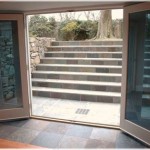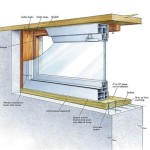How To Make Basement Steps Not So Steep
Basement steps are often steep, posing a safety hazard for homeowners and guests. Steep steps can make it difficult to navigate, increase the risk of falls, and present challenges for individuals with mobility issues. Fortunately, there are several effective strategies to make basement steps less steep. This article will delve into various techniques, providing guidance and practical tips for improving the safety and accessibility of your basement stairs.
1. Increase the Rise Height
The rise of a step refers to its vertical height. To make basement steps less steep, increasing the rise height is a common solution. When you increase the rise height, you reduce the number of steps needed to reach the desired level, thereby reducing the overall steepness of the staircase. However, it's important to note that there are building codes and regulations that dictate the maximum permissible rise height for each step. In general, the recommended rise height for residential stairs is 7 to 7.75 inches.
To increase the rise height, you can consider adding a layer of material to the existing steps, such as wood, concrete, or tile. The amount of material you add will determine the change in rise height, so careful planning and measurement are essential. If you are adding a significant amount of material, ensure the stair stringers, which are the supporting beams, are strong enough to handle the added weight. However, altering the structural integrity of the basement steps is a complex task that should only be undertaken by experienced professionals.
2. Decrease the Run Length
The run of a step refers to its horizontal depth. To make basement steps less steep, decreasing the run length is another effective technique. This means making each step shallower, which will reduce the incline and make them easier to navigate.
To decrease the run length, you can consider adding a landing or intermediate platform to the staircase. This will break up the length of the stairway and make it less steep. The landing should have a minimum width of 3 feet and a depth of 3 feet, complying with building codes. Additionally, if you are adding a new landing, ensure that you have sufficient structural support for the platform. Consider hiring a qualified contractor to assess the structural integrity before proceeding with alterations.
3. Add Handrails
Handrails are essential safety features for any staircase, particularly for steep basement stairs. They provide stability and support, helping users maintain their balance and prevent falls. Handrails should be installed on both sides of the stairway, ensuring they extend the full length of the stairs. Building codes specify the minimum height for handrails, typically 34 to 38 inches from the tread surface.
When choosing handrail materials, consider factors such as durability, ease of maintenance, and aesthetics. Popular materials for handrails include wood, stainless steel, wrought iron, and vinyl. Ensure that the handrail is securely mounted to the wall or stair stringers, using appropriate fasteners and brackets. You can consider adding contrasting colors or materials to the handrails, making them more visible and easier to locate.
4. Improve Lighting
Adequate lighting is crucial for safety and visibility on any staircase, especially in basements. Poor lighting can create shadows and make it difficult to see the steps, increasing the risk of tripping or falling. Ensure your basement stairs have sufficient lighting to illuminate the entire stairwell, the landing, and the basement floor.
Consider installing multiple light fixtures, including a ceiling fixture, wall sconces, or under-stair lights. Use bright, white bulbs, and consider adding dimmer switches to allow for adjustable lighting levels. You can also install motion-activated lights to ensure the stairway is illuminated when needed. Ensure that the lighting is evenly distributed and does not create glare or shadows.
5. Use Anti-Slip Materials
Slippery surfaces pose a significant safety hazard on stairs. To enhance traction and prevent slips, consider implementing anti-slip materials on the steps. Common anti-slip solutions include applying non-slip paint or coatings to the treads, using textured or patterned tiles, or adding non-slip carpet runners.
When selecting anti-slip materials, consider factors such as durability, ease of cleaning, and aesthetics. Ensure that the chosen materials are suitable for the stairs' material and are installed correctly to maximize their effectiveness. Avoid using materials that can become slippery when wet, such as polished marble.
Before implementing any changes to your basement stairs, it is essential to consult with a qualified contractor or building professional to ensure that your project complies with local building codes and regulations. Additionally, they can offer expert advice on structural integrity, materials, and safety recommendations.

How To Make Steep Stairs Safer On A Budget

How To Convert Bottom Of Straight Stairway Three Step Winder Easy Home Remodeling Tutorial

This Could Be Your Final Solution To Problem Fixing Small Steps With Tall Risers Make Safe

How To Make Steep Stairs Safer On A Budget

Our Magazine Worthy Diy Basement Stairs Makeover Beautiful On A Budget This Life

How Can I Best Change A Steep Staircase Into Safer One Hometalk

How To Increase Individual Stair Step Depth For The Entire Stairway Home Remodeling Tips

Basement Stair Stringers By Fast Stairs Com

My Stairs Are Too Steep How Can I Make Them Better

Our Magazine Worthy Diy Basement Stairs Makeover Beautiful On A Budget This Life
Related Posts







